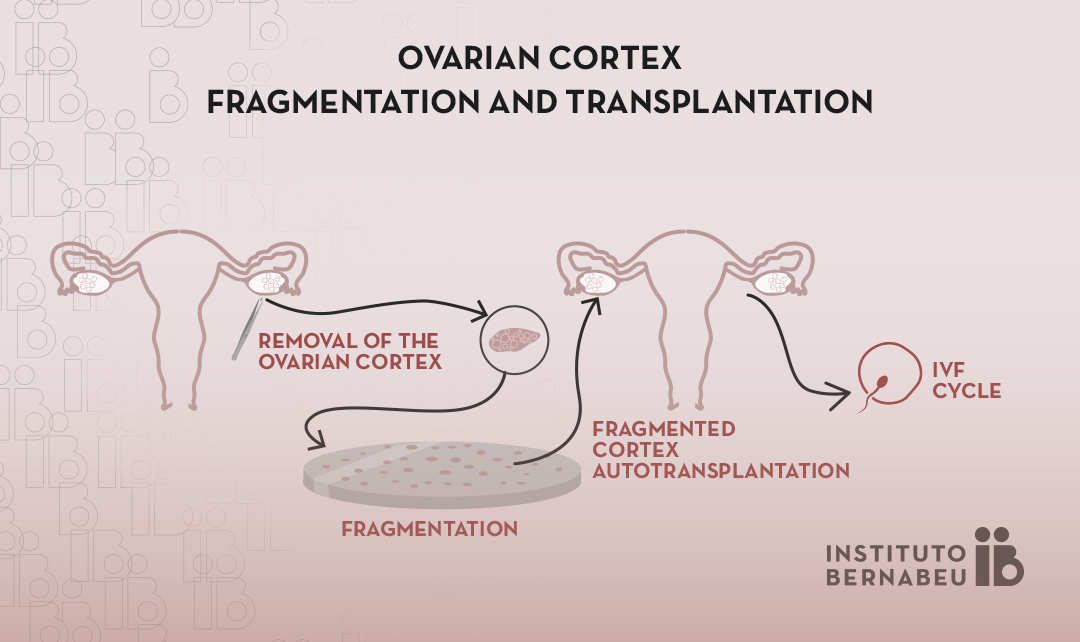
Ovarian rejuvenation through fragmentation and transplantation of ovarian cortex
Ovarian reserve is determined at birth and continually decreases both in quantity and in quality until it completely runs out during the menopause in women aged around 45 to 50. However, around 1% of women, for a range of different reasons, experience premature depletion of their ova, leading to a total or partial end to ovarian function before they are 40. This is known as premature ovarian failure or premature ovarian insufficiency.
In these patients, the ovaries stop producing ova that can be fertilised and, even though in some cases women have spontaneous ovulation cycles, there are no tests to help indicate whether this might happen and, if so, when. In these cases, ovarian stimulation treatment is not effective and the only other options available if a woman wishes to have a child include donation of ova (egg donation), embryo adoption and adoption.
Activation of residual follicles: OFFA
However, it was discovered many years ago that, following the menopause, the ovary contains some residual follicles and several research projects have sought to discover ‘ovary activation’ techniques so that these patients can fall pregnant.
Several studies have found that removal of part of the ovarian cortex in small fragments, followed by reinsertion, can lead to activation of ovarian function. In fact, recovery of residual ‘dormant’ follicles in the ovaries of women with complete ovarian failure has been described, in addition to spontaneous pregnancies and pregnancies following in vitro fertilisation. This is what is known as OFFA (Ovarian Fragmentation for Follicular Activation).

How is it performed?
In 2013, Dr Kawamura from Japan spoke of ‘activation of dormant follicles’ in young patients with premature ovarian failure. The technique, which has a range of variants, has been performed over the last few years in clinics around the world and spontaneous pregnancies and pregnancies following in vitro fertilisation in some treated patients have been described.
The ovarian activation process consists of removing part of the ovarian cortex, fragmentation of that cortex and positioning of the fragments in several areas close to the ovary. A laparoscopy, or surgical intervention, is needed in order to do this. It entails using a camera and several instruments inserted into the abdomen through small incisions, making it possible to view the pelvic organs and proceed guided by direct vision. This is followed by ovarian stimulation through administration of hormones so that oocytes can be obtained and fertilised using in vitro fertilisation techniques.
The treatment is suitable for relatively young patients with ovarian failure or premature menopause with the aim of achieving a pregnancy using their own ova. The medical team assesses the suitability of performing the technique in each case.
Dr Ana Fuentes, gyneacologist at Instituto Bernabeu
Bibliography
- Kawamura K, Ishizuka B, Hsueh AJW. Drug-free in-vitro activation of follicles for infertility treatment in poor ovarian response patients with decreased ovarian reserve. Reprod Biomed Online. 2020 Feb;40(2):245-253. doi: 10.1016/j.rbmo.2019.09.007.
- Lunding SA, Pors SE, Kristensen SG, Landersoe SK, Jeppesen JV, Flachs EM, Pinborg A, Macklon KT, Pedersen AT, Andersen CY, Andersen AN. Biopsying, fragmentation and autotransplantation of fresh ovarian cortical tissue in infertile women with diminished ovarian reserve. Hum Reprod. 2019 Oct 2;34(10):1924-1936. doi: 10.1093/humrep/dez152.
- Fabregues F, Ferreri J, Calafell JM, Moreno V, Borrás A, Manau D, Carmona F. Pregnancy after drug-free in vitro activation of follicles and fresh tissue autotransplantation in primary ovarian insufficiency patient: a case report and literature review. J Ovarian Res. 2018 Aug 31;11(1):76. doi: 10.1186/s13048-018-0447-3.
- Zhai J, Yao G, Dong F, Bu Z, Cheng Y, Sato Y, Hu L, Zhang Y, Wang J, Dai S, Li J, Sun J, Hsueh AJ, Kawamura K, Sun Y. In Vitro Activation of Follicles and Fresh Tissue Auto-transplantation in Primary Ovarian Insufficiency Patients. J Clin Endocrinol Metab. 2016 Nov;101(11):4405-4412.
The following may also be of interest to you
